Ah Dubai, the Burj Khalifa, the Dubai Fountain, the Iceberg, the Palm, … Wait, what?! Imagine a huge piece of Ice, 3 kilometers long, just next to the Palm Jumeirah 7-star hotel, splashing in 35-degree water.
Iceberg Water may sound utterly crazy, yet it may soon become a reality! And you know what? It may even be a sustainable and affordable source of drinking water.
This is part of my exploration of the fundamentals of Water
Table of contents
- Iceberg Water in the News
- Towing an Iceberg to the United Arab Emirates
- Iceberg Towing is two centuries old
- The Godfather of Iceberg Towing & Iceberg Water
- Iceberg Towing becomes a Daily Reality
- RAND as a strong promoter of Iceberg Water Projects
- Prince Mohammed’s Dream: Towing an Iceberg to Saudi Arabia
- An Iceberg Water revival, 20 years later
- An Iceberg to bring Drinking Water to Cape Town
- Iceberg Water: Conclusion
Iceberg Water in the News
Some weeks ago, a LinkedIn post from Nuria Claramunt Folch caught my attention.
She shared a BBC article listing three alternative sources of water that may solve the drinking water crisis.
It featured desalination – quite an obvious application in the Water Industry nowadays.
Atmospheric water generation – a topic that I have explored with Navkaran Singh Bagga from AKVO.
And… iceberg harvesting.
I don’t know about you, but to me, that Iceberg thing felt like a joke.
Or maybe worse, opportunistic exploitation of global warming.
Yet, the article linked to an enigmatic project in Dubaï, so I decided to go down the rabbit hole.
If you’re like me, and you never heard before of Iceberg harvesting, you’ll feel like Socrates – or Jon Snow – you’ll realize that you know nothing.

So suspend your disbelief for a minute and embark with me; you’ll be surprised!
Towing an Iceberg to the United Arab Emirates
Abdulla Alshehi is an ambitious businessman with a dream: bringing an Iceberg to the United Arab Emirates.
He wrote about that in a book, ten years ago. And honestly, not all the Ideas listed in that book were fully ready to be implemented.

Alshehi actually has four arguments to promote his Iceberg project.
1. Icebergs as a source of Drinking Water
First and above all, a big chunk of Ice happens to be a perfect reservoir of drinking water. Mining an iceberg the size Alshehi ambitions to float to the Emirates would, according to him, cover the needs of one million people for up to five years.
We’ve already seen that iceberg water is pretty popular when bottled, so there’s no reason why a Point of Use production of the purest water there is on Earth wouldn’t appeal to Dubai residents.
Hence, the plan is to replicate a practice that’s quite common in, for instance, Canada, where, besides water bottles, melted icebergs also serve as the key ingredient to the World’s purest Vodka.
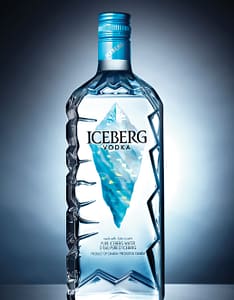
But according to Abdulla Alshehi, the benefits don’t stop there. Indeed, his second good reason is environmental.
2. Iceberg Water = Less Desalination
The drinking water produced through the melted Iceberg would be so much less water that would need to come out of a desalination plant.
Which in turn, means fewer brines rejected to the sea, a factor that’s not to neglect when you consider that the Emirate’s desalination plants account for 15% of the World’s capacity.
3. An Iceberg to bring Rain in the Desert
Good Reason number three: bringing rain in the Desert. Indeed, there shall be a column of cold air above the Iceberg, attracting clouds and more clouds means more rain.
The argument sounds about right if we consider that the Iceberg will create a cold front. Now, keep in mind, I’m not a meteorological expert either.
4. An Iceberg to attract Tourists
Finally, in a region where people come to ski indoor, having a chance to walk on a real iceberg while having the Palm or the Burj Khalifa as a background for your selfies is clearly an appeal for new forms of tourism.
And I said “tourism” – not “sustainable tourism.”
If we wrap up all the advantages, the full project starts to make sense!
Now, there is a tiny little detail to sort out, but I can’t put my finger on it…
Oh, right. You JUST need to find an Iceberg and convey it to the Emirates.
Wait! I see your ironic smile behind the screen. “Ah, Dubai is at it again.”
But what if I told you that towing Icebergs is an Idea that’s been around for about two centuries?
Iceberg Towing is two centuries old
Look, an 1825 essay collection published in London already mentions the “old project of towing icebergs into the southern ocean, for the purpose of equalizing the temperature on earth.”

See, at the time, we had ambition!
But that wasn’t just a vaporous project; the Encyclopedia of Antarctica reports how small icebergs were towed for refrigerating purposes in breweries in the mid-nineteenth century.

Small ships were conveying them from Laguna San Rafael to Valparaiso, sometimes even mounting sails on the icebergs.
Many Iceberg Water projects – not all were serious!
Then, when there’s money on the line, you can count on American entrepreneurs to pop in. In 1863, the ninth volume of the Scientific American reports how a “Genius in New Bedford” is developing a steamer to tow icebergs to India, where they sell for six cents a pound.
Yet even more disruptive, another one plans to fit a screw in the Iceberg itself, thus avoiding the expense of shipbuilding.
Don’t laugh; the British army seriously considered and tested the option of icebergs as an aircraft carrier during the second world war!

Before that, in 1914, the Washington Times featured an ad:
“Wanted – Tugboat captains and ice dealers who would be interested in towing icebergs into harbors.”
The ad was from the Northern Berg Ice Company, which was planning to tow icebergs into Boston, New York, Baltimore, and Philadelphia, exhibit them by excursion steamers, and then dynamite the bergs into small pieces for the ice market.
That furiously resembles the 2021 Dubai project, no?
The Godfather of Iceberg Towing & Iceberg Water
1949 is the year where all of that gets a bit more serious when John Isaacs mentions an Iceberg Towing project.

In a seminar at the Scripps Oceanic Institute where he worked, he suggests towing an Antarctic iceberg north across the equator to bring fresh water to southern California.
Isaacs’ Idea emerged as he was working on a project to transfer Columbia River water to California in an underwater pipe. He swiftly realized that the larger the pipe was, the cheaper it was becoming in terms of cost per cubic meter.
The rationale behind Iceberg Towing
But a very large pipe was swiftly becoming thus large that it contained enough water to supply much more than entire southern California. So why not keeping a large pipe but reduce its length? So his project became a container.
But a container, given its cost, would have to travel back, once emptied from his water, so it became a ship.
But a ship would cost as much in one day of propulsion than the worth of the entire water it contains…
And if you look at the size needed, it would be roughly the volume of… you guessed it, a tabular Antarctic iceberg. Plus, that floats much better and does not need a pipe, a container, or a ship to wrap it.
John Isaacs’ Iceberg Project in numbers
John Isaacs later expanded on the Idea and estimated the Ideal Iceberg shall be an eight-billion-ton one, thirty kilometers long, one kilometer wide and 300 meters deep.
110 Titanics long, 35 Titanics wide, and 6 Titanics deep.
Towing it from Antarctica to San Diego would take 200 days, and as it would leverage as much as possible from the sea currents, it would only cost 0.001 cents per ton to move.
Now, according to Isaacs, at the size of that Iceberg, it would still represent an energy need of one to two atomic bombs.
That may sound pharaonic, but he puts it in comparison with the energy needed to desalinate the same amount of water, which would rather be in the scale of tens of thousands of atomic bombs.
And yes, I agree with you, using atomic bombs as a measurement unit is probably not the most convenient move.
John Isaacs’ opinion on the Dubai Iceberg Project
John Isaacs kept expanding on his Iceberg Ideas for the rest of his career. Even though he died in 1980, and thus never met Abdulla Alshehi, he got eventually asked what he thought of towing an Iceberg to the Middle East when that project first emerged in the 1970s.
To him, it sounded at best a bad Idea, if not impossible. His rationale was that towing Antarctica Icebergs would have much more to do with surfing ocean currents than with goods shipment.
Hence, it may be wiser to first target places like Chile, Peru, South Africa, or Australia.
But we’ll come back to that.
For now, we see that the cost of an Iceberg-based resource builds a rationale over interbasin water transfers or desalination. And dragging it across the Globe by leveraging sea currents is at least serious enough for science people like Isaacs to dare to expose the Idea.
Iceberg Towing becomes a Daily Reality
But so far, aside from the small pieces, the Chilean brewers were dragging, that full topic of Iceberg Towing is still very theoretical.
That all changed in the 1960s when oil companies developed an actual towing technology to move icebergs.
Nothing overly complicated: you circle the Iceberg with a rope and pull it with a ship from a distance of about 200 meters.
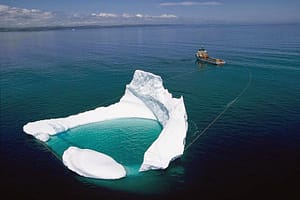
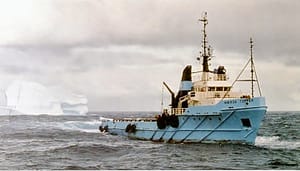
Oil Companies didn’t do that to harvest the Icebergs for Drinking Water purposes. They just wanted to avoid a reverse Titanic incident. Because Oil rigs may not be moving, but Icebergs are!
A proof of concept that serves the Iceberg Water projects
So, since the 1960s, they employ Iceberg hunters that drag the pieces of Ice out of the Oil Platform’s direct neighborhood. That’s commonplace nowadays, as hundreds of Icebergs are deflected from Oil rig’s trajectory every year.
If the fifties were the decade of the Ideation, with John Isaacs, and the sixties the decade of the Proof of Concept with the Oil Rigs’ Iceberg hunters, the seventies would be the decade where all of that becomes mainstream.
RAND as a strong promoter of Iceberg Water Projects
In 1973, RAND, one of the World’s largest think tanks, produces a 96 pages report for the National Science Foundation simply called “Antarctic Icebergs as a Global Fresh Water Resource.”
To them, the Idea is not only possible but simply brilliant. They start by assessing the opportunity: with one trillion cubic meters of Icebergs produced in Antarctica every year, that renewable water source could possibly cover the Water Needs of 5 billion people.
They then estimate that the Icebergs’ climate impact is negligible compared with the Antarctica sea and land ice. So you could harvest all of them with very little if any impact.
Anyways, they recommend aiming for 10% of the Icebergs, at least to start with, and to select the best-shaped ones, thanks to NASA satellite imaging.
RAND also modeled the actual towing and estimated that winds and currents would be factors to consider. Still, long after Coriolis forces, the convoy would need to overcome.
Ideal Shape of an Iceberg Train
Hence, they calculated the optimal shape and size of the expedition with this formula, where D is the drag in newtons, V the…
BORING
Ok, let me jump to conclusions: the Ideal train should be twenty kilometers long, 600 meters wide, and 300 meters deep.

So 74 Titanics long… Yeah, that was only funny once.
Icebergs in the train shall be insulated by wrapping them in plastic sheets, and moved with electrical propellers. To power all of that, no less than a floating nuclear power plant shall be installed at the rear of the train.
The cost of Iceberg Water
Fine, but how much would it cost? According to RAND, about eight dollars per thousand cubic meters of Ice towed, and another eight dollars per thousand cubic meters to transform that Ice into drinking water upon arrival.
Factoring in the transfer of that water to distribution terminals on-shore, that study accounts for a thirty dollar price tag per thousand cubic meters of Iceberg water.
Hence RAND’s conclusion confirms John Isaacs’ intuition: all in all, Iceberg water is much cheaper than desalination, interbasin water transfers, or water reclamation. To quote them: “The more avenues that are explored, the more promising the concepts seem to become.”
And that triggered many concepts!
Blooming Iceberg Towing Projects
One of the paper’s authors, John Hult, left RAND to create his company with the project to wrap an Iceberg in plastic and tow it to Southern California for 30 million dollars. He would then bottle it in souvenirs for tourists and sell the bulk of it as Drinking Water to Los Angeles.
And that attracted a major player in this Iceberg harvesting game: Prince Mohammed bin Faisal Al Saud, son of the King of Saudi Arabia.
The Prince was then the official in charge of Saudi Arabia’s desalination program, which he saw as costly and inefficient, requiring vast amounts of capital to build desalination plants, and equally vast amounts of energy to run them.
Intrigued and appealed by RAND’s report, he started investigating the Iceberg topic. In June 1977, the New York Times reports on one of his Ideas with french explorator Paul-Emile Victor: using nuclear submarines to push Icebergs to arid places of the World.

Prince Mohammed’s Dream: Towing an Iceberg to Saudi Arabia
In October, he funded an Iceberg conference at the Iowa University, where he was joined by scientists from 18 countries. To make a lasting impression, he proceeded to capture and transport a piece of Alaskan Iceberg through helicopter, plane, and truck. Congress attendees thus enjoyed parts of the World’s most expensive piece of Ice as coolers for their cocktails.
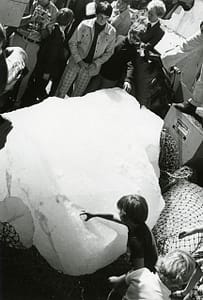

The conference became an annual event and perdured into the 1980s.
In 1978, the California legislature became the first public body to officially approve an Iceberg towing project, and in 1979 NASA integrates it into its Ice and Climate research program.
Prince Mohammed’s Iceberg Towing Company
Prince Mohammed creates his dedicated company, Iceberg Towing International, and appoints a french engineer, Georges Mougin, as CEO.
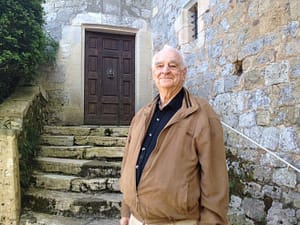
But the interest starts to cool down. Indeed, moving Icebergs around still raises many questions. What would be the international acceptability of exploiting Antarctic resources? What may be the environmental consequences along the way and upon arrival?
End of the Iceberg Mania
And probably the most problematic one: are we really sure that the melting process won’t be too fast? Wilford Weeks of the U.S. Army Cold Regions Research and Engineering Laboratory was vocal about that concern in a Time Magazine article. “Once you get north of the equator, you’ll have nothing but a rope at the end of your tow.”
So the Iceberg towing topic only served as a joke in the “Brewster’s millions” movie, while Prince Mohammed moved on, stopped financing research, and closed its Iceberg Company in 1980.
An Iceberg Water revival, 20 years later
Is that full story over? Indeed not at all. Georges Mougin, Prince Mohammed’s Company’s former CEO, kept the dream alive.
He went through a kind of desert, as no serious new project emerged for almost two decades. But in 2003, Mougin teamed up with Dassault Systèmes, to leverage a revolution.
In twenty years, many things had changed. He now had access to much more meteorological data, and you no longer needed NASA’s involvement to have live access to satellite data.
But even more game-changing, modeling had made a quantum leap. That’s how the model built by the team showed that, towing a 7 million ton tabular iceberg would only request one single tugboat, with a 130 tons traction strength.
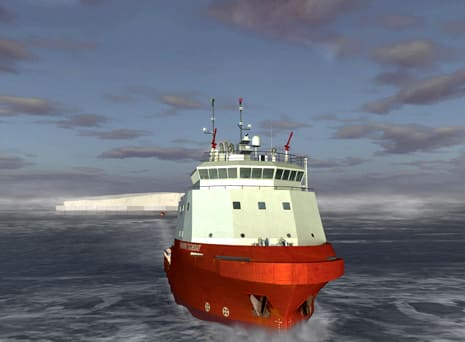
The Canaria Iceberg Project
The Iceberg would travel at a speed of little under a knot. And it would take 141 days to complete a journey from Newfoundland to the Canaria while losing 38% of its masses.
Now, unless I missed a big news, I never heard of an Iceberg that would effectively have reached the Canaria. It seems like that project faded out for unknown reasons around 2013 after a movie was made on it in 2011.
And still today Abdulla Alshehi builds its Dubai Iceberg Project’s credibility by placing it in Prince Mohammed and Georges Mougin’s legacy.
To my knowledge, the 91-year old Mougin is not directly involved in the Emirates today. But that doesn’t mean he renounced his dream either!
He’s maybe the last man standing from the pioneers we’ve covered, like John Isaacs, John Hult, or Prince Mohammed.
An Iceberg to bring Drinking Water to Cape Town
But, he’s now associated with another project, currently led by Nicholas Sloane in South Africa.
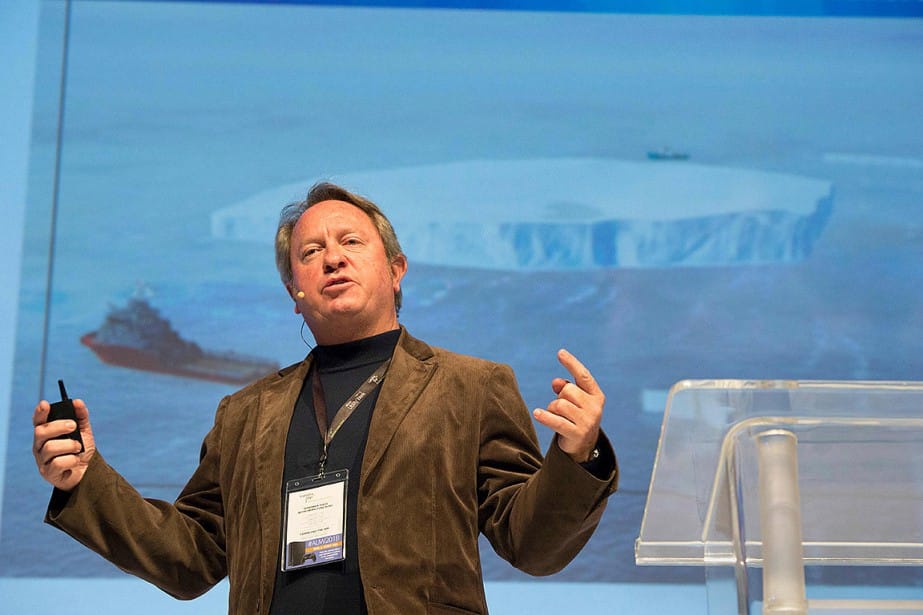
If there’s one city in the World that’s well aware that there’s a 40% gap between the World’s projected water withdrawals in 2030 and the existing accessible and reliable water supplies, it’s Cape Town.
Indeed, they went very close to Day Zero in 2017, and even if last-minute rain finally bettered the situation, they know that Climate Change won’t give them a rest.
Hence Nick Sloane’s project to tow an Iceberg to Cape Town. Sloane, who notably was in charge of refloating the infamous Costa Concordia, would deal with the towing, and Mougin bring his 40 years Iceberg background.
A team of experts to support the South African Iceberg Project
These two have also built a full team of experts around them, like Olav Orheim, a former director of the Norwegian Polar Institute; Marcello Vichi, a professor of oceanography at the University of Cape Town; and Alan Condron… Well, I’ll let Alan introduce himself.
I had the chance to cut two long-form interviews with Alan Condron and Abdulla Alshehi for the (don’t) Waste Water podcast, so make sure to subscribe if you don’t want to miss it! Actually, Alan covers the ins and outs of Iceberg Towing from a scientific point of view and tells us a bit about the Cape Town project, while Abdulla takes us through the steps and stages of the Emirati project.
So will an Iceberg ever float next to Cape Town, San Diego, Perth, or Dubai? Will it be crushed and mixed in the desperately drying reservoirs of cities in arid places? Who knows? Not me.
Iceberg Water: Conclusion
So don’t ask me to bet on whether Abdullah Alshehi in Dubai or Nicholas Sloane in Cape Town will be the first to do it, again, you can build an Idea for yourself by listening to both of their long-form interviews.
But when Sloane declares to Bloomberg’s Businessweek that he thinks that twenty or thirty years from now, towing icebergs will be a regular thing, I have to say, so thought John Isaacs 70 years ago, and it still did not happen.
Yet, in a world where people pay a fortune to acquire bottled iceberg water, it is honestly quite surprising that no one has taken the plunge yet. And it surely deserves much more than the raised eyebrow I had at the beginning of this investigation.
Iceberg Water is much more serious than I first thought
In February, two United Nations scientists published a paper for the World Economic Forum, reviewing alternative water sources that may solve dry areas’ challenges. And Iceberg harvesting made it to their shortlist.
John Isaacs once said that “the general innovative process taught in our society and ingrained in even our best engineers and scientists is one that represents only marginal changes from past practice. But real innovation comes from exploring concepts based on the notion that there is something fundamentally wrong about past practices!”
So what do you think, will we soon see Icebergs in every marina?
See you soon!

